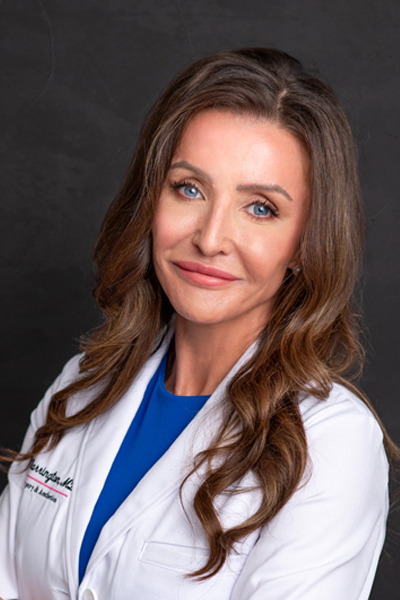Saline vs. Silicone: Understanding the Types of Breast Implants
July 23, 2025Categories: Plastic Surgery
Thinking of getting breast implants? You’re not alone. For years, breast augmentation has remained one of the most popular cosmetic procedures in America.
With multiple types of breast implants, which is right for you?
“Choosing to undergo breast augmentation or breast reconstruction surgery is a very personal choice,” says Dr. Heidi Harrington, board-certified and fellowship-trained plastic surgeon at Beaufort Memorial Plastic Surgery & Aesthetics. “What kind of implant you go with is just as personal, as each option has its own set of perks.”
What Are Breast Implants?
As defined by the U.S. Food and Drug Administration, breast implants “are medical devices implanted under the breast tissue or chest muscle.” These devices are sought for two reasons that can improve comfort and confidence.
- Enhancing breast size or shape — Women who aren’t happy with their natural breasts can increase breast size or shape with implants.
- Restoring breast shape — Following trauma or breast cancer surgery, implants can restore a more natural appearance.
Currently, women in the United States have access to two FDA-approved implants: saline- and silicone gel-filled implants. These two types of breast implants have a few things in common. With both implant types, you can expect the following:
- Long-lasting results — Today’s breast implants have relatively low rupture rates in the first 10 years after placement. However, studies show that the risk of rupture increases with time.
- Annual monitoring — To ensure your implants remain in good shape, you will need to visit your healthcare provider on a regular basis.
- Safe experience — Decades of advancements in breast implant technology have contributed to a strong safety record, which may be a key factor in the FDA's continued approval of these devices.
- Silicone shells — Both silicone- and saline-filled breast implants have silicone shells. These shells are both inert and biocompatible. In other words, they don’t change and don’t negatively affect human tissue (biocompatible).
Similar as they are, silicone and saline implants have differences. The most obvious is the material inside each. Understanding what’s inside each can help you decide which implant is best for you.
Read More: Mommy Makeover: Reclaiming Your Confidence
Silicone-Filled Implants
Silicone comes from silicon, a semimetallic element that combines with oxygen in nature to form silicon dioxide, or silica. Silica is found in beach sand, crystals and quartz, making it one of the most common substances on Earth. To produce silicon, silica is heated with carbon at high temperatures. This silicon can then be processed to create a long chemical chain called silicone, which can be a liquid, gel or rubbery substance. Silicone breast implants use silicone gel. To qualify for silicone breast augmentation, you must be at least 18 years old.
“Silicone breast implants have undergone extensive medical research,” Dr. Harrington says. “All of this research has produced a safe way to enhance the size and shape of the breasts, making you more comfortable in your body for years to come.”
This type of breast implant provides benefits, including:
- Appearing more natural
- Feeling like natural breasts
Saline Breast Implants
Saline implants are water-based and filled with saline solution. Depending on your cosmetic surgeon’s preferences, these implants may be prefilled or filled in during your procedure. This type of breast augmentation is available for women aged 18 or older.
Benefits of saline-filled breast implants include:
- Firmness — Saline breast implants often appear firmer and more pronounced than silicone implants.
- Smaller incision — Your plastic surgeon can often work through a smaller incision and leave less scar tissue when placing saline implants.
Read More: Know Your Lemons: How to Do a Breast Self-Exam
Potential Downsides to the Different Types of Breast Implants
Breast implants often provide years of boosted confidence. On occasion, however, an issue may arise. Issues you may experience include the following:
- Breast implant-associated anaplastic large cell lymphoma (BIA-ALCL) — BIA-ALCL is not a type of breast cancer. It’s an immune system cancer that can cause swelling, pain or a mass at the site of the breast implant. Symptoms may begin years after placement. Though typically confined to the area surrounding the implant, it can spread to various parts of the body. If you experience swelling or pain, consult your healthcare provider for evaluation and possible imaging.
- Repeated surgeries — Depending on the age of your implants, your particular health situation or how long ago you had a breast enhancement procedure, you may need a second or third breast augmentation surgery. Keep in mind that multiple surgeries carry additional risks, so discuss your options thoroughly with your surgeon.
- Rupture — With silicone implants, leaking silicone usually remains within the breast area. This can make it difficult to know when a rupture has occurred, as the leaked silicone continues to support breast shape. Over time, breast size may change, and you may experience tingling or other sensations in the breast. A rupture is more obvious with a saline-filled implant. The saline escapes the shell, and your body quickly absorbs the saline, leaving the affected breast with a deflated appearance. If you suspect a rupture, seek immediate medical attention to assess and address the issue.
Read More: Breast Reduction Surgery: Is It Right for You?
Choosing the right Type of Breast Implant
When choosing between the types of breast implants, saline and silicone is just one decision. Other considerations include:
- Body type — Your breast implants should fit your body, body type and goals. By knowing what you want, you can guide your plastic surgeon toward the look you desire.
- Finances — Some types of breast implants, such as teardrop-shaped implants, are more expensive. Knowing this up front helps you know what options fit your budget.
- Shape — Round breast implants cause the breasts to be round and full at the top. Teardrop-shaped implants, on the other hand, add more size to the lower part of the breasts.
- Size — Breast implants can be subtle or obvious, depending on your desires.
Alongside these considerations, there’s one other thing to keep in mind.
“The most vital part to any breast augmentation is your care team,” Dr. Harrington says. “Working with a caring board-certified plastic surgeon positions you to have a wonderful surgical experience and results you cherish for as long as the implants remain in place.”
Considering breast augmentation? Call 843-940-8520 to schedule a plastic surgery consultation today or request an appointment online.

